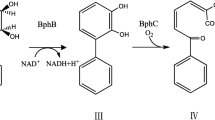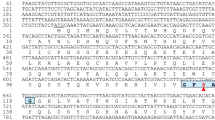Abstract
Methyl parathion hydrolase (MPH) from a methyl parathion-degrading Burkholderia cepacia indigenous to Thailand was purified to apparent homogeneity by three steps of column chromatography using Resource S, Sephadex G100, and Octyl Sepharose 4FF columns. Its molecular mass was determined to be 35 kDa, and the pI to be 8.5. The recombinant plasmid pGT1, containing the MPH-encoding gene, mpdB, cloned into pGEX-4T-2 was over-expressed in Escherichia coli as GST-MPH fusion protein. The recombinant MPH was purified to homogeneity by a single step, using GSTPrep FF affinity column, with the molecular mass identical to that of the native enzyme. The purified enzyme had the specific activity of about 1,600 unit mg−1 protein and the yield of about 75%, a 39-fold increase in recovery compared to that of the native enzyme. The optimal temperature and pH were 25°C and 9.0, respectively. The MPH was stable, with its activity unchanged for 48 h at 4°C, and reduced to 50% after 5 h and to 45% after 48 h at 25°C. The enzyme activity remained 80–90% after 8–15 h at pH 6–7. Cd2+, Co2+, and Zn2+ ions at the concentration of 1 mM enhanced the activity; while sodium dodecyl sulfate (SDS), dithiothreitol (DTT) and ethylenediaminetetraacetate (EDTA) reduced it. The enzyme also showed cross reactivity with other insecticides within the organophosphate group, and the kinetic parameters for individual substrates were investigated. Since MPH from B. cepacia has wide potential applications in detoxification and detection of organophosphate compounds, this study provides important basis for its future use.







Similar content being viewed by others
References
Abou-Donia MB (2003) Organophosphorus ester-induced chronic neurotoxicity. Arch Environ Health 58:484–497
Ausubel FA, Brent R, Kingston RE, Moore DD, Seidman JG, Smith JA, Struhl K (1997) Current protocols in molecular biology. Wiley, New York
Chaudhry GR, Ali AN, Wheeler WB (1988) Isolation of a methyl parathion-degrading Pseudomonas sp. that possesses DNA homologous to the opd gene from a Flavobacterium sp. Appl Environ Microbiol 54:288–293
Chibani Azaiez SR, Fliss I, Simard RE, Moineau S (1998) Monoclonal antibodies raised against native major capsid proteins of lactococcal c2-like bacteriophages. Appl Environ Microbiol 64:4255–4259
Cho CM-H, Mulchandani A, Chen W (2006a) Functional analysis of organophosphorus hydrolase variants with high degradation activity towards organophosphate pesticides. Protein Eng 19(3):99–105
Cho TM, Wild JR, Donnelly KC, Tiffany-Castiglioni E (2006b) Degradation of organophosphorus neurotoxicity in SY5Y neuroblastoma cells by organophosphorus hydrolase (OPH). J Toxicol Environ Health A 69(15):1413–1429
Choi JW, Min J, Jung JW, Rhee HW, Lee WH (1998) Fiber-optic biosensor for the detection of organophosphorus compounds using AChE-immobilized viologen LB films. Thin Solid Films 327–329:676–680
Compton JA (1988) Military chemical and biological agents. Telford Press, New Jersey
Cui ZL, Li SP, Fu G (2001) Isolation of methyl parathion-degrading strain M6 and cloning of the methyl parathion hydrolase gene. Appl Environ Microbiol 67:4922–4925
Dawson RM, Pantelidis S, Rose HR, Kotsonis SE (2008) Degradation of nerve agents by an organophosphate-degrading agent (OpdA). J Hazard Mater 157:308–314
Du D, Cai J, Song D, Zhang A (2007) Rapid determination of triazophos using acetyl cholinesterase biosensor based on sol–gel interface assembling multiwall carbon nanotubes. J Appl Electrochem 37:893–898
Edman P (1950) Method for determination of the amino acid sequence in peptides. Acta Chem Scand 4:283–293
Furlong CE, Richter RJ, Chapline C, Crabb JW (1991) Purification of rabbit and human serum paraoxonase. Biochemistry 30:10133–10140
Görg A, Obermaier C, Boguth G, Harder A, Scheibe B, Wildgruber R, Weiss W (2000) The current state of two-dimensional electrophoresis with immobilized pH gradients. Electrophoresis 21:1037–1053
Harper LL, McDaniel CS, Miller CE, Wild JR (1988) Dissimilar plasmids isolation from Pseudomonas diminuta MG and a Flavobacterium sp. (ATCC 27551) contain identical opd genes. Appl Environ Microbiol 54:2586–2589
Horne I, Sutherland TD, Harcourt RL, Russell RJ, Oakeshott JG (2002) Identification of an opd (organophosphate degradation) gene in an Agrobacterium isolate. Appl Environ Microbiol 68:3371–3376
Kang DG, Kim JY-H, Cha HJ (2002) Enhanced detoxification of organophosphates using recombinant Escherichia coli with co-expression of organophosphorus hydrolase and bacterial hemoglobin. Biotechnol Lett 24:879–883
Keprasertsup C, Upatham S, Sukhapanth N, Prempree P (2001) Degradation of methyl parathion in an aqueous medium by soil bacteria. Sci Asia 27:261–270
Laemmli U (1970) Cleavage of structural proteins during the assembly of the head of bacteriophage T4. Nature 277:680–685
Lowry OH, Rosebrough NJ, Farr AL, Randall RJ (1951) Protein measurement with the folin phenol reagent. J Biol Chem 193:265–275
McDaniel CS, Harper LL, Wild JR (1988) Cloning and sequencing of a plasmid-bourne gene (opd) encoding a phosphotriesterase. J Bacteriol 170:2306–2311
Mulbry WW, Karns JS (1989) Parathion hydrolase specified by the Flavobacterium opd gene: relationship between the gene and protein. J Bacteriol 171:6740–6746
Mulbry WW, Karns JS, Kearney PC, Nelson JO, McDaniel CS, Wild JR (1986) Identification of a plasmid-bourne parathion hydrolase gene from Flavobacterium sp. by Southern hybridization with opd from Pseudomonas diminuta. Appl Environ Microbiol 51:926–930
Mulchandani P, Chen W, Mulchandani A, Wang J, Chen L (2001) Biosensors for direct determination of organophosphate pesticides. Biosens Bioelectron 16(4–5):225–230
Rowland SS, Speedie MK, Pogell BM (1991) Purification and characterization of a secreted recombinant phosphotriesterase (parathion hydrolase) from Streptomyces lividans. Appl Environ Microbiol 57:440–444
Sambrook J, Fritsch EF, Maniatis T (1989) Molecular cloning: a laboratory manual, 2nd edn. Cold Spring Harbor Laboratory Press, Cold Spring Harbor
Serdar CM, Gibson DT (1985) Enzymatic hydrolysis of organophosphates: cloning and expression of a parathion hydrolase gene from Pseudomonas diminuta. Bio/Technology 3:567–571
Serdar CM, Gibson DT, Munnecke DM, Lancaster JH (1982) Plasmid involvement in parathion hydrolysis by Pseudomonas diminuta. Appl Environ Microbiol 44:246–249
Serdar CM, Murdock DC, Rohde MF (1989) Parathion hydrolase gene from Pseudomonas diminuta MG: subcloning, complete nucleotide sequence, and expression of the mature portion of the enzyme in Escherichia coli. Bio/Technology 7:1151–1155
Sethunathan N, Yoshida T (1973) A Flavobacterium sp. that degrades diazenon and parathion. Can J Microbiol 19:873–875
Votchitseva YA, Efremenko EN, Aliev TK, Varfolomeyev SD (2006) Properties of hexahistidine-tagged organophosphate hydrolase. Biochemistry (Moscow) 71(2):167–172
Wongthianlai S, Chimthong S, Srirattana K, Wichitwechkarn J (2007) Identification, cloning, and expression of mpd gene coding for methyl parathion hydrolase from Burkholderia cepacia. In: Proceedings of the 33th congress on science and technology of Thailand, Nakhon Si Thammarat, Thailand
Acknowledgments
We thank Prof. Suchart Upatham for providing MP-degrading B. cepacia, and Dr. Preeyaporn Koedrith for technical assistance. Thanks to Prof. Klostermeyer, parts of MPH purification and N-terminal amino acid sequence determination were done at Lehrstuhl fuer Chemie der Biopolymer, TU-Muenchen, Germany. This work was supported by grants from The National Biotechnology Center and in part by The National Nanotechnology Center, Thailand.
Conflict of interest
The authors declare that they have no conflict of interest.
Author information
Authors and Affiliations
Corresponding author
Rights and permissions
About this article
Cite this article
Ekkhunnatham, A., Jongsareejit, B., Yamkunthong, W. et al. Purification and characterization of methyl parathion hydrolase from Burkholderia cepacia capable of degrading organophosphate insecticides. World J Microbiol Biotechnol 28, 1739–1746 (2012). https://doi.org/10.1007/s11274-011-0985-y
Received:
Accepted:
Published:
Issue Date:
DOI: https://doi.org/10.1007/s11274-011-0985-y




